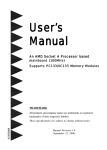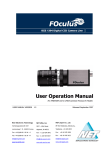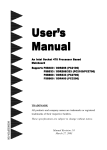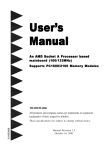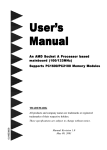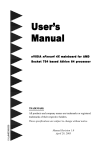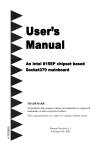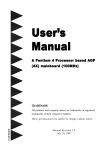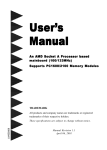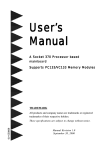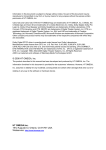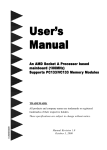Download User`s Manual
Transcript
User’s Manual nVIDIA nForce2-128 IGP mainboard for AMD Socket A processor TRADEMARK All products and company names are trademarks or registered trademarks of their respective holders. These specifications are subject to change without notice. 6000002RGM310 Manual Revision 1.0 February 04, 2004 DISCLAIMER OF WARRANTIES: THERE ARE NO WARRANTIES WHICH EXTEND BEYOND THE DESCRIPTION ON THE FACE OF THE MANUFACTURER LIMITED WARRANTY. THE MANUFACTURER EXPRESSLY EXCLUDES ALL OTHER WARRANTIES, EXPRESS OR IMPLIED, REGARDING ITS PRODUCTS; INCLUDING ANY IMPLIED WARRANTIES OF MERCHANTABILITY, FITNESS FOR A PARTICULAR PURPOSE OR NONINFRINGEMENT. THIS DISCLAIMER OF WARRANTIES SHALL APPLY TO THE EXTENT ALLOWED UNDER LOCAL LAWS IN THE COUNTRY PURCHASED IN WHICH LOCAL LAWS DO NOT ALLOW OR LIMIT THE EXCLUSION OF THE IMPLIED WARRANTIES. ii Table of Contents Section 1 Page Introduction Package Contents ................................................ 1-1 Overview AthlonTM Processors ............................................ 1- 2 Chipset Overview ................................................. 1- 3 Accelerated Graphics Port ................................... 1- 4 Ultra ATA66/100/133 ............................................ 1- 4 Hardware Monitoring ........................................... 1- 4 LAN (Optional) ..................................................... 1- 4 IEEE 1394 (Optional) ............................................. 1- 4 I/O Shield Connector ............................................ 1- 5 Power-On/Off (Remote) ........................................ 1- 5 System Block Diagram .......................................... 1- 6 Section 2 Features Mainboard Features ............................................. 2-1 Section 3 Installation Mainboard Layout ............................................... 3- 2 Easy Installation Procedure CPU Insertion ....................................................... 3- 3 Jumper Settings .................................................... 3- 5 System Memory Configuration ............................ 3- 6 Expansion Slots .................................................... 3- 8 Device Connectors ............................................... 3- 10 ACPI S3 (Suspend To RAM) Function ................ 3- 16 iii Section 4 BIOS Setup BIOS Instructions ................................................. 4- 1 Standard CMOS Setup ......................................... 4- 2 Advanced BIOS Features ..................................... 4- 3 Advanced Chipset Features ................................ 4- 7 Integrated Peripherals .......................................... 4- 11 Power Management Setup ................................... 4- 16 PNP/PCI Configuration Setup .............................. 4- 18 PC Health Status .................................................. 4- 20 Defaults Menu ..................................................... 4- 22 Supervisor/User Password Setting ...................... 4- 23 Exit Selecting ........................................................ 4- 24 Section 5 Driver Installation Easy Driver Installation ........................................ 5- 1 C-Media Audio Configuration Brief Guide ........... 5- 2 GeForce4MX Integrated GPU .............................. 5- 9 Appendix Appendix A Update Your System BIOS ................................... A- 1 Appendix B EEPROM BIOS Remover ...................................... B- 1 Appendix C GHOST 7 Quick User’s Guide (Optional) ................. C- 1 iv Introduction Section 1 INTRODUCTION Package Contents Contents Optional Items A. Mainboard G. COM port cable B. User’s manual H. IEEE 1394 two ports cable C. Floppy disk drive cable I. Extra USB2.0 port cable D. HDD drive cable J. S/PDIF Module E. CD (drivers and utilities) If you need the optional item, please contact your dealer for assistance. F. I/O Shield E USER’S MANUAL C D B F A G I J H Page 1-1 Introduction AthlonTM Processors The AMD AthlonTM is a seventh-generation micro architecture with an integrated L2 cache, which is powerful enough to support the bandwidth requirements of a large range of applications, hardware, graphics, and memory technologies. These processors implement advanced design techniques such as: Socket A (PGA 462) 266/333/400MHz system interface based on the Alpha™ EV6 bus protocol. Three out-of-order, superscalar, pipelined Multimedia Units. Three out-of-order, superscaler, pipelined Integer Units. Fixed-sized internal instruction formats (MacroOPs). 72-entry Instruction Control Units. AMD enhanced 3DNow!™ technology L1 and L2 caches. Dynamic branch prediction. Socket A is the name for AMD’s new socketed interface designed to support AMD AthlonTM processors. This innovation is made possible by integrating the L2 cache memory on chip with the processor. Socket A will help enable smaller enclosures, and ultimately result in a wider variety of solutions in the market. The AthlonTM processors in the Socket A format continue to deliver the ultimate performance for cutting-edge applications. Both bring to desktop systems running industry-standard x86 software superscalar RISC performance. Being provided in the Socket A format they are the world’s most powerful x86 processors. They easily deliver the highest integer, floating-point, and 3D multimedia performance for applications running on x86 platforms around. It features full-speed, on-chip cache memory, a 266/333/400MHz front side system bus, and enhanced 3DNow!™ technology. The AMD AthlonTM processor is targeted at the performance segment, and as such will have more cache memory and higher clock speeds. Page 1-2 Introduction Chipset Overview This board is designed with nVidia chipset, nForce2TM IGP-128 as North Bridge and nForce2TM MCP as South Bridge. NVIDIA® provide the highest-performance, fullest-featured system architecture for the AMD Athlon XP Processor™. The second generation System Platform Processor works together with the second generation of the NVIDIA Media Communication Processor, the MCP. The nForce2 was architected specifically for the AMD AthlonXP Processor. NVIDIA’s patent-pending DASP (Dynamic Adaptive Speculative Pre-Processor) technology intelligently predicts and prefetches requests from the AMD Athlon XP Processor to boost system performance beyond its nominal speed grade. The nForce2 IGP-128 delivers twice the bandwidth by implementing the new NVIDIA DualDDR™ Memory Architecture speed to DDR333 memories. This generation System Platform Processor also implements the AGP 8× interface, HyperTransport Link, and is fully compliant with industry standard power management specifications such as ACPI 2.0 and PCI Power Management Interface (PMI) Spec 1.1. The NVIDIA® nForce™ MCP Media and Communications Processor (MCP) provides a highly integrated, high-performance, low-cost PC2001-compliant peripheral controller that supports NVIDIA processor bridge functionality for next-generation PCs. No other single-device controller provides all the functionality of NVIDIA’s MCP. Page 1-3 Introduction Accelerated Graphics Port (AGP) The AGP slot on the board is compliant with the new AGP 3.0 specification. This new specification enhances the functionality of the original AGP specification by allowing 8X data transfers ( 8 data samples per clock) resulting in maximum bandwidth of 2.1GB/s. In addition, it defines 1.5 volt power supply operation. Complying with this specification, this board supports external AGP-8X/4X cards with Fast Write Transactions. Only 1.5V AGP cards are supported. Ultra ATA/66/100/133 The MCP provides two independent ATA133 IDE controllers, supporting standard programmable input/output (PIO) and Direct Memory Access (DMA) mode operations, as well as UltraDMA-133/100/66/33 standards for a maximum data transfer rate of 133MB/sec per channel. Hardware Monitoring Hardware monitoring enables you to monitor various aspects of the system operation and status. The features include CPU temperature, voltage and fan speed in RPMs. LAN (Optional) This mainboard is optionally mounted with LAN chipset. It allows the mainboard to connect to a local area network by means of a network hub. IEEE1394 (Optional) IEEE 1394 is a high-speed serial bus developed by Apple that allows users to connect up to 63 devices to the serial bus on a PC. IEEE is sometimes called the IEEE 1394 standard, the i.Link connector, FireWire, and the High Performance Serial Bus (HPSB). IEEE 1394 provides transfer rates up to 400Mbits/sec. IEEE 1394 provides enhanced PC connectivity for consumer electronics audio/video (A/V) appliances, storage peripherals, portable devices such as digital cameras, and inter-PC communications. IEEE 1394 supports hot swapping, multiple speeds on the same bus, and isochronous data transfer providing much needed bandwidth for multimedia operations. Page 1-4 Introduction I/O Shield Connector The I/O back panel for this mainboard is shown below (Figure 1). When installing the mainboard into the computer case, use the bundled I/O shield to protect this back panel. Parallel Port PS/2 Mouse RJ45 LAN (Optional) Line-in/Rear out (Light Blue) Line-out/Front out (Lime) PS/2 Keyboard Mic-in/Center&Subwoofer (Pink) VGA2 VGA1 USB2.0 USB2.0 ports ports Figure 1: I/O back panel layout Power-On/Off (Remote) This board has a 20-pin ATX and a 4-pin ATX12V power supply connector to support power supplies with Remote On/Off feature. The chassis power button should be connected to the mainboard front panel PW_ON header (Figure 2). You can turn off the system in two ways: by pressing the front panel power On/Off button or using the "Soft Off" function that can be controlled by an operating system such as Windows®XP/ME/2000/98. Note: For maintaining the DDR SDRAM power during STR (ACPI S3) function, it is strongly recommended to use power supplies that have a +5VSB current of (>=) 2A. Please check the 5VSB’s specification printed on the power supply’s outer case. Note: The board requires a minimum of 250 Watt power supply to operate. Your system configuration (amount of memory, add-in cards, peripherals, etc.) may exceed this minimum power requirement. To ensure that adequate power, use a 300 Watt (or higher) power supply. 12V 4-pin POWER SUPPLY 20-pin PW-ON Case (chassis) Power ON/OFF button (PW-ON) Figure 2: Simple ATX power ON/OFF controller Page 1-5 Introduction System Block Diagram Figure 3: System Block Diagram Page 1-6 Features Section 2 FEATURES Mainboard Features Processor Supports 462-pin Socket A for AMD Athlon XP and Barton processors with 266/333/400MHz Front Side Bus - Athlon XP (1500+ to 2800+) with 266/333MHz Front Side Bus, - Barton (2500+ to 3200+) with 333/400MHz Front Side Bus Chipset nVidia AGPset : nForce2-128 IGP + MCP - Integrated GeForce4 MX graphics controller - Dual VGA connectors for nView multi-display technology support Main Memory Two 184-pin DDR DIMM sockets for 64-bit, Unbuffered, Single/Doubleside and Non-ECC DDR-200/266/333 DIMMs Supports 128-bit dual channel memory architecture Supports up to 2GB memory size BIOS Flash EEPROM with Award BIOS - ACPI v2.0 compliant - S3 (Suspend to DRAM) sleep-state support - SMBIOS (System Management BIOS) v2.2 compliant - Supports Power failure recovery - Able to wake the computer from specific states by LAN, Power switch, PME#, RTC alarm, USB, PS2 KB&Mouse, Modem ring on COM#1… Onboard PCI Devices LAN --> (Optional) Embedded 10/100Mbps Fast Ethernet controller with Realtek RTL8201BL PHY Page 2-1 Features 1394 --> Integrated 1394 controller with VIA VT6307 for 2 ports solution (Optional) - IEEE-1394a compliant with up to 400Mbps bandwidth Legacy IO Controller Winbond W83627HF LPC IO controller with keyboard, mouse, floppy, printer, serial and CIR/SIR interface Audio Six channel audio with analog and digital output using C-Media CMI9739A AC’97 CODEC - AC’97 v2.2 compliant - In 2-CH mode, supports Line-In (Light Blue), Line-Out (Lime) and Mic-In (Pink) at rear panel - In 6-CH mode, supports Rear speaker out (Light Blue), Front speaker out (Lime) and Center&Subwoofer speaker out (Pink) at rear panel - Supports CD-In, AUX-In and S/PDIF-in/out interface - Supports Line-out and Mic-In for front panel Peripheral Interfaces ) At Rear Panel PS/2 keyboard and mouse ports One Parallel (printer) port Two VGA port One RJ45 LAN connector (Optional) Four USB2.0 ports Three Audio jacks ) Onboard connector and pin-header One floppy drive connector Two ATA-133 IDE connectors Two extra USB2.0 ports One CD-IN and One AUX-IN connector One S/PDIF in/out connector Page 2-2 Features One IR connector One Front Panel Audio connector Two COM port connectors Two 1394 connectors (Optional) Two Fan connectors Front Panel Controller Supports Reset & Soft-Off switches Supports HDD & Power LEDs Supports PC speaker Expansion Slots One AGP slot supporting 1.5v 4X/8X AGP cards - AGP v3.0 compliant Two PCI slots with Bus Master support - PCI v2.2 compliant Special Features Magic Health – a BIOS H/W monitoring utility for voltage, temperature and fan-speed sensing displayed during POST EZ Boot – A simple shortcut to select the boot device, e.g. hard drive, CDROM or floppy without entering CMOS setup KBPO – Keyboard Power On, turn on the computer from the keyboard Power BIOS for excellent over clocking capabilities through - subtle frequency tuning on FSB Form Factor 245mm x 245mm Micro ATX size Page 2-3 Features Page 2-4 Installation Section 3 INSTALLATION Page 3-1 Installation Mainboard Layout Figure 1 Page 3-2 Installation Easy Installation Procedure The following must be completed before powering on your new system: 3-1. CPU Installation 3-2. Jumper Settings 3-3. System Memory Configuration 3-4. Expansion Slots 3-5. Device Connectors 3-1 CPU Installation CPU Insertion: (use AMD AthlonTM as reference) Step 1 Open the socket by raising the actuation lever. Figure 2 Step 2 Insert the processor. Figure 3 Ensure proper pin 1 orientation by aligning the FC-PGA corner marking with the socket corner closest to the actuation arm tip. The pin field is keyed to prevent misoriented insertion. Don’t force processor into socket. If it does not go in easily, check for mis-orientation and debris. Make sure the processor is fully inserted into the socket on all sides. Page 3-3 Installation Step 3 Close the socket by lowering and locking the actuation lever. Figure 4 Step 4 Thermal compound and qualified heatsink recommended by AMD are a must to avoid CPU overheat damage. For more information about installing your CPU, please refer to the AMD website article “Socket A AMD processor and Heatsink Installation Guide” http://www.amd.com/products/cpg/athlon/pdf/23986.pdf. Figure 5 Page 3-4 Installation 3-2 Jumper Settings JCMOS: Clear CMOS data Jumper If the CMOS data becomes corrupted or you forgot the supervisor or user password, clear the CMOS data to reconfigure the system back to the default values stored in the ROM BIOS. 1 Settings: 1-2: Normal (Default) 2-3: Clear CMOS To CMOS Clear data, please follow the steps below. 1. Turn off the system. 2. Change the jumper from “1-2” to “2-3” position for a few seconds. 3. Replace the jumper on to the “1-2” position. 4. Turn on the system and hold down the <Del> key to enter BIOS setup. JCLK: CPU FSB Select Jumper This jumper is used to select the front side bus of the CPU installed on the mainboard. 1 Settings: 1-2: 100/133MHz 2-3: 133/166/200MHz (Default) Note: Overclocking may cause system instability and are not guaranteed to provide better system performance. Page 3-5 Installation 3-3 System Memory Configuration Memory Layout The mainboard accommodates two PC1600/2100/2700 184-pin DIMMs (Dual In-line Memory Modules): • Supports up to 2.0GB of 200/266/333MHz DDR SDRAM • Supports up to 2 DDR DIMMs (refer to Table 1) • Supports 64/128/256/512Mb, 1Gb x8 & x16 DRAMs • Supports 128-bit dual channel memory architecture • Supports unbuffered and non-ECC DIMMs • Supports configurations defined in the JEDEC DDR DIMM specification Figure 6 and Table 1 show two possible memory configurations. <Figure 6> <Table 1> DDR DIMM 2 Bank 1 DDR DIMM 1 Bank 0 1 DIMM (64- bit) DIMM#1 DIMM#2 SS/DS 2 DIMM (128- bit) SS/DS SS/DS SS/DS * SS: Single-Sided DIMM, DS: Double-Sided DIMM NOTES: • For one DIMM memory configuration, the DIMM can be located on any of DIMM#1 to DIMM#2 in 64-bit mode. • For two DIMMs memory configuration, the DIMMs can be located on all DIMM socket to enable 128-bit mode. It is preferable to use DRAM DIMM of the same type and size. • Using non-compliant memory with higher bus speeds (overclocking) may severely compromise the integrity of the system. Page 3-6 Installation DIMM Module Installation Figure 7 displays the notch on the DDR DIMM memory module. DIMMs have 184 pins and one notch that matches with the DDR DIMM socket. DIMM modules are installed by placing the chip firmly into the socket and pressing straight down as shown in figure 8 until the white clips close and the module fits tightly into the DIMM socket (figure 9). CENTER KEY ZONE (2.5 V DRAM) Figure 7 - DIMM notch Figure 8 - DIMM module clips before installation Figure 9 - DIMM module clip after installation To remove the DIMM module press down the white clips and the module will be ejected from the socket. Page 3-7 Installation 3-4 Expansion Slots AGP Slot The mainboard is equipped with an AGP slot. Make sure you install a card that supports the 1.5V specification. AGP Slot PCI Slots PCI Slots The mainboard is equipped with 2 PCI slots. Installing an Expansion Card The steps below assume that the mainboard is already installed in the system chassis. 1. Make sure the PC and all other peripheral devices connected to its has been powered down. 2. Disconnect all power cords and cables. 3. Remove the system unit cover. 4. Remove the bracket of the slot that you intend to use. (You need to remove the screw in order to remove the bracket.) 5. Align the card above the slot then press it down firmly until it is completely seated in the slot. 6. Secure the card to the chassis with the screw you removed in step 4. 7. Replace the system unit cover. 8. Power on the PC. 9. Enter the BIOS step program to make the necessary settings. 10. Save the settings and restart the PC. 11. Install the software drivers of the expansion cards, if necessary. Page 3-8 Installation AGP Card Installation Caution 1. AGP card component is blocked by DIMM socket lock. 2. AGP slot clicker is not locked. 3. AGP card edge connector is not inserted properly. 1. AGP card component is not blocked by DIMM socket lock. 2. AGP slot clicker is locked. 3. AGP card edge connector is inserted properly. 1. AGP slot clicker is not locked. 2. AGP card edge connector is not inserted properly. 1. AGP slot clicker is locked. 2. AGP card edge connector is inserted properly. Page 3-9 Installation 3-5 Device Connectors RJ45 LAN Parallel Port (Optional) PS/2 Mouse PS/2 Keyboard Line-in/Rear out (Light Blue) Line-out/Front out (Lime) Mic-in/Center&Subwoofer (Pink) VGA2 VGA1 USB2.0 USB2.0 ports ports Figure 10 - I/O Ports JPWR_FAN JCPU_FAN JCPU_FAN / JPWR_FAN: CPU/Power Fan Power Connectors JCPU_FAN: The CPU must be kept cool by using a fan with heatsink. JPWR_FAN: If you are installing an additional fan in the unit, connect to this fan connector. JCPU_FAN JPWR_FAN +12V Sence Ground +12V Sence Ground The system is capable of monitoring the fan speed in RPM (Revolutions Per Minute). Refer to the PC Health Status submenu of the BIOS for the current speed of the CPU fan and power fan. COM1/COM2: Serial Port Connectors The serial ports can be used with modems, serial printers, remote display terminals, and other serial device. RTS RI DSR CTS NC 2 1 COM1 COM2 Page 3-10 10 9 DCD TXD Ground RXD DTR Installation FDD1: Floppy Controller Connector This mainboard connects up to 2 floppy disk drives. FDD IDE1 IDE2 34 33 40 IDE1/IDE2:Ultra DMA-66/100/133 Primary/Secondary IDE Connector This mainboard is equipped with 2 IDE connectors to support up to 4 ATA-133 IDE drives. It supports PIO and DMA mode operations for maximum data transfer rate of 133MB/sec per channel. 39 When using two IDE drives, one must be set to Master mode and the other to Slave mode. Refer to your disk drive user’s manual for information about selecting the proper drive switch settings. 1 2 FDD 2 1 IDE1/IDE2 PW1: 20-pin ATX Power Connector PW12: 4-pin ATX12V Power Connector The mainboard is equipped with a standard 20-pin ATX main power connector and a 4-pin +12V power connector for connecting an ATX12V power supply. The plugs of the power cables are designed to fit in only one orientation. Insert the plugs into the connectors until they fit in place. PW1 PW12 10 20 +12V +5V 5VSB 3 +12V Ground +5V +12V PW-OK Ground +5V Ground Ground Ground +5V PS-ON Ground 3.3V Ground -12V 4 1 2 PW12 -5V Ground Ground 3.3V 3.3V 1 11 PW1 Caution: The PW1 and PW12 Power Connector must be used simultaneously or else the system will not boot-up. The board requires a minimum of 250 Watt power supply to operate. Your system configuration (amount of memory, add-in cards, peripherals, etc.) may exceed this minimum power requirement. To ensure that adequate power, use a 300 Watt or greater power supply. Page 3-11 Installation AUD2: Front Panel Audio Connector When the jumpers are removed this connector can be used for front panel audio. The front panel phone jack should have a “normal close” switch . Without a phoneplug inserted, the rear panel audio is enabled. With phone plug inserted, the rear panel audio will be disabled. MIC_In 1 2 GND +5V NC Front Line-out-R Rear Line-out-FR Key Rear Line-out-FL Front Line-out-L 9 10 Settings Pins (5-6) & (9-10) Short (default): Only the onboard rear panel audio jack can be used. Pins (5-6) & (9-10) Open: Only front panel audio jack can be used. In 2-Channel audio mode, Mic-In is shared for both front panel and rear panel. In 6-Channel audio mode, the Mic-In is dedicated for front panel use, and rear panel Mic-In function will switch to Center and Subwoofer support. CD-IN1/AUX-IN1: CD Audio_IN Connector The CD-IN1 and AUX-IN1 connectors are used to receive audio form a CD-ROM drive, TV tuner or MPEG card. CD-IN CD-IN1 AUX-IN1 AUX-IN CD_IN_Right AUX_IN_Right CD_Reference 1 Page 3-12 CD_IN_Left GND 1 AUX_IN_Left Installation SPDIF: Sony/Philips Digital InterFace connector This connector is the digital link between the mainboard and your audio devices, such as CD player, sampler or DAT recorder. It allows the digital transmission of audio data in S/PDIF format. SPDIF_IN VCC 5 1 6 2 NC GND SPDIF_OUT C1394-1 / C1394-2: (Optional) 400Mpbs 1394a (FireWire) Connectors These connectors enable you to connect two IEEE 1394 ports for with external devices that conform to the IEEE 1394 specification. C1394-1 C1394-2 TPB+ +12V (Fused) GND TPA+ Key 9 1 2 10 GND TPA+12V (Fused) GND TPB- JCFP3: Case-open header This jumper is used to detect chassis intrusion. 1 Page 3-13 Installation CUSB3: Two USB 2.0 ports USB2.0 allows data transfer speed up to 480Mbps. This mainboard includes 2 additional USB 2.0 ports, identified by two 10-pin connector. CUSB3 If you wish to use the additional USB ports, install the card-edge bracket to the system chassis then insert its cables to this 10-pin connector. CAUTION ! Please make sure the USB cable has the same pin assignment. A different pin assignment may cause damage to the system. If you need the USB cable, please contact our retailer. Page 3-14 Installation CFP: Front Panel Connector HD_LED This LED will light up whenever the hard drive is being accessed. PWR_LED This connects to the power button of the system chassis CFP / CIR / CSPK RST This switch allows you to reboot without having to power off the system thus prolonging the life of the power supply or system. PW_ON This is connected to the power button on the case. To use the Soft-Off by PWR-BTTN feature, refer to Power Management Setup in the BIOS section of this manual. CIR: IR connector Connect your IrDA cable to this IR connector. 1. VCC 4. GND 2. CIRRX 5. IRTX 3. IRRX CSPK: Speaker Connect to the system’s speaker for beeping 1. VCC 3. GND 2. NC 4. Speaker Page 3-15 Installation 3-6 ACPI S3 (Suspend To RAM) Function This mainboard supports the STR (Suspend To RAM) power management scheme by maintaining the appropriate power states in the DDR SDRAM interface signals. The power source to the DDR SDRAM is kept active during STR (ACPI S3). Advanced Configuration Power Interface (ACPI) provides many Energy Saving Features for operating systems that support Instant ON and QuickStartTM function. 1. To enable STR functionality to save system power : a. Install ACPI certified add-on cards (such as AGP, LAN, and modem cards). b. In BIOS, under Power Management Setup (refer to Section 4), select “ACPI Suspend Type: S3(STR)”. If you have a USB mouse or keyboard, set “USB Resume from S3” to “Enabled”. c. Install Windows® XP/2000/ME/98SE. d. Restart the system. e. When in Windows, open the Control Panel Power Management application, and click the Advanced tab. In the Power buttons section, select “Stand By” from the drop-down lists. 2. To activate the STR function: a. Click the START button and choose Shut Down. b. In the Shut Down Windows dialog box, select the Stand By option to enter STR mode. The following are the differences between STR power saving mode and Suspend (Power On Suspend) mode: a. STR is the most advanced Power Management mode. b. STR cuts all the power supplied to peripherals except to memory - max. power saving. c. STR saves and keeps all on-screen data including any executed applications to DDR SDRAM. d. In STR mode, you must push the power button (connected to the onboard PWOn of CFP pin), click your USB mouse buttons, or press your USB keyboard keys to wake up your system to the last display. Page 3-16 BIOS Section 4 BIOS SETUP Main Menu The ROM BIOS contains a built-in Setup program which allows user to modify the basic system configuration and hardware parameters. The modified data is stored in a battery-backed CMOS, so that data will be retained even when the power is turned off. In general, the information saved in the CMOS RAM will stay unchanged unless there is a configuration change in the system, such as hard drive replacement or a device is added. It is possible for the CMOS battery to fail causing CMOS data loss. If this happens you will need install a new CMOS battery and reconfigure your BIOS settings. The BIOS setup screen and description are for reference only, and may not exactly match what you see on your screen. The contents of BIOS are subject to change without notice. Please visit our website for updates. To enter the Setup Program : Power on the computer and press the <Del> key during the POST (Power On Self Test). The BIOS CMOS SETUP UTILITY opens. Figure 1: CMOS Setup Utility Page 4-1 BIOS The main menu displays all the major selection items. Select the item you need to reconfigure. The selection is made by moving the cursor (press any direction (arrow key ) to the item and pressing the ‘Enter’ key. An on-line help message is displayed at the bottom of the screen as the cursor is moved to various items which provides a better understanding of each function. When a selection is made, the menu of the selected item will appear so that the user can modify associated configuration parameters. 4-1 Standard CMOS Setup Choose “STANDARD CMOS FEATURES” in the CMOS SETUP UTILITY Menu (Figure 2). Standard CMOS Features Setup allows the user to configure system settings such as the current date and time, type of hard disk drive installed, floppy drive type, and display type. Memory size is auto-detected by the BIOS and displayed for your reference. When a field is highlighted (use direction keys to move the cursor and the <Enter> key to select), the entries in the field can be changed by pressing the <PgDn> or the <PgUp> key. Figure 2: Standard CMOS Setup Page 4-2 BIOS Notes: • If the hard disk Primary Master/Slave and Secondary Master/Slave are set to Auto, the hard disk size and model will be auto-detected. • The “Halt On:” field is used to determine when the BIOS will halt the system if an error occurs. • Floppy 3 Mode support is a mode used to support a special 3.5-inch drive used in Japan. This is a 3.5-inch disk that stores 1.2 MB. The default setting for this is disabled. 4-2 Advanced BIOS Features Selecting the “ADVANCED BIOS FEATURES” option in the CMOS SETUP UTILITY menu allows users to change system related parameters in the displayed menu. This menu shows all of the manufacturer’s default values for the board. Pressing the [F1] key displays a help message for the selected item. Figure 3: BIOS Features Setup Page 4-3 BIOS Virus Warning During and after system boot up, any attempt to write to the boot sector or partition table of the hard disk drive halts the system and an error message appears. You should then run an anti-virus program to locate the virus. Keep in mind that this feature protects only the boot sector, not the entire hard drive. The default is Disabled. Enabled: Activates automatically when the system boots up causing a warning message to appear when anything attempts to access the boot sector. Disabled: No warning message appears when anything attempts to access the boot sector. Note: Many disk diagnostic programs that access the boot sector table can trigger the virus warning message. If you plan to run such a program, we recommend that you first disable the virus warning. CPU Internal Cache This controls the status of the processor’s internal cache area. Options: Enabled, Disabled. External Cache This controls the status of the external (L2) cache area. Options: Enabled, Disabled. Quick Power On Self Test This category speeds up the Power On Self Test (POST). The default is Enabled. Enabled: This setting will shorten or skip of the items checked during POST. Disabled: Normal POST. First /Second/Third/Other Boot Device The BIOS attempts to load the operating system from the devices in the sequence selected in these items. Options: Floppy, LS120, HDD-0, SCSI/SATA, CDROM, HDD-1, HDD-2, HDD-3, ZIP100, USB-FDD, USB-ZIP, USB-CDROM, LAN, Disabled. Boot Other Device When enabled, the system searches all other possible locations for an operating system if it fails to find one in the devices specified under the first, second, and third boot devices. The default is Enabled. Options: Enabled, Disabled. Page 4-4 BIOS Swap Floppy Drive This will swap your physical drive letters A & B if you are using two floppy disks. Enabled: Floppy A & B will be swapped under the O/S. Disabled: Floppy A & B will be not swapped. Boot Up Floppy Seek If this item is enabled, it checks the size of the floppy disk drives at start-up time. You don’t need to enable this item unless you have a legacy diskette drive with 360K capacity. The default is Disabled. Options: Enabled, Disabled. Boot Up NumLock Status This controls the state of the NumLock key when the system boots. The default is On. On: The keypad acts as a 10-key pad. Off: The keypad acts like cursor keys. Gate A20 Option This refers to the way the system addresses memory above 1 MB (extended memory). Normal: The A20 signal is controlled by the keyboard controller or chipset hardware. Fast: The A20 signal is controlled by Port 92 or chipset specific method. Security Option This category allows you to limit access to the System and Setup, or just to Setup. The default is Setup. System: The system will not boot and the access to Setup will be denied if the correct password is not entered at the prompt. Setup: The system will boot; but the access to Setup will be denied if the incorrect password is not entered at the prompt. APIC Mode This item allows you to enable APIC (Advanced Programmable Interrupt Controller) functionality. Options: Enabled, Disabled. MPS Version Control For OS Specifies the Multiprocessor Specification (MPS). Version 1.4 supports multiple PCI bus configurations by incorporating extended bus definitions. Enable this for Windows NT or Linux. For older operating systems, select Version 1.1. Options: 1.1, 1.4. Page 4-5 BIOS HDD S.M.A.R.T. Capability The S.M.A.R.T. (Self-Monitoring, Analysis, and Reporting Technology) system is a diagnostics technology that monitors and predicts device performance. S.M.A.R.T. Software resides on both the disk drive and the host computer. The disk drive software monitors the internal performance of the motors, media, heads, and electronics of the drive. The host software monitors the overall reliability status of the drive. If a device failure is predicted, the host software, through the Client WORKS S.M.A.R.T applet, warns the user of the impending condition and advises appropriate action to protect the data. The default is Disabled. Options: Enabled, Disabled. Full Screen LOGO Show This item allows you determine Full Screen LOGO display during POST. Options: Enabled, Disabled. Small Logo (EPA) Show If the BIOS contains an internal bitmap picture, this option sets the bitmap display at the top right corner of the screen. Options: Enabled, Disabled. Page 4-6 BIOS 4-3 Advanced Chipset Features Choose the “ADVANCED CHIPSET FEATURES” option in the CMOS SETUP UTILITY menu to display following menu. Figure 4: Chipset Features Setup System Performance This item will help you to configure your system performance. Options: Optimal, Aggressive, Turbo, Expert. Note: Selecting higher performance may cause instability. FSB Frequency Enables you to set the CPU frontside bus speed. Enables you to subtle tuning FSB. Note: Overclocking failure will cause no display on monitor. At this instant, press <Insert> key to revert back to the initial or default setting to boot up your system. CPU Interface Allows you to set CPU/FSB parameters for CPU most stable or overclocked. Options: Optimal, Aggressive. Page 4-7 BIOS Memory Frequency Enables you to select the memory frequency. Options: By SPD, 50%, 60%, 66%, 75%, 80%, 83%, 100%, 120%, 125%, 133%, 150%, 166%, 200%, Auto. Below is a list of Auto mode table for reference. FS B SPD/Memory 200 266 Sync/Async and Speed set Sync 200 200 333 Sync 200 266 266 Sync 266 266 333 Sync 266 333 266 Async 333/266 333 333 Sync 333 400 266 Async 400/266 400 333 Async 400/333 Note: Auto mode ensures the memory init module initializes the memory controller for the best performance based on the FSB and DDR SPD capabilities. Memory Timings For setting DRAM Timing. Options: Optimal, Aggressive, Turbo, Expert. T (RAS) This item specifies the number of clock cycles needed after a bank active command before a precharge can occur (sets the minimum RAS pulse width.). Options: 1 ~ 15. T (RCD) This item sets the timing parameters for the system memory such as the CAS (Column Address Strobe) and RAS (Row Address Strobe). Options: 1 ~ 7. T (RP) This item refers to the number of cycles required to return data to its original location to close the bank or the number of cycles required to page memory before the next bank activate command can be issued. Options: 1 ~ 7. Page 4-8 BIOS CAS Latency Enables you to select the CAS latency time. The value is set at the factory depending on the DRAM installed. Do not change the values in this field unless you change specifications of the installed DRAM. Options: 2.0, 2.5, 3.0. FSB Spread Spectrum This item can significantly reduce the EMI (ElectroMagnetic Interference) generated by the CPU. Options: Disabled, 0.50%, 1.00%. AGP Spread Spectrum This item can significantly reduce the EMI (ElectroMagnetic Interference) generated by the AGP. Options: Disabled, 0.50%, 1.00%. Frame Buffer Size This item allows you to select the main memory frame buffer size of AGP. Options: 8, 16, 32, 64, 128MB, Disabled. AGP Aperture Size (MB) This item defines the size of the aperture if you use an AGP graphics adapter. It refers to a section of the PCI memory address range used for graphics memory. Options: 32, 64, 128, 256, 512 MB. AGP Slot Frequency This item allows you to select the AGP slot frequency. Options: Auto, 50MHz, 90MHz, 93MHz, 95MHz, 97MHz, 100MHz, 66MHz ~87MHz in 1MHz increments. Onchip AGP Frequency This item allows you to select the Onchip AGP frequency. Options: 100MHz, 110Mhz, 120MHz, 130MHz. AGP 8X Support Enables AGP 8X supports. Options: Disabled, Enabled. Page 4-9 BIOS AGP Fast Write Capability This item allows you to use Fast Write protocol for AGP card. Options: Disabled, Enabled. CPU Thermal-Throttling This item sets the percentage of time that the CPU is idled if CPU throttling is initiated by excess heat. The default setting is 50%. Options: 12.5%, 25.0%, 37.5%, 50.0%, 62.5%, 75.0%, 87.5%. System BIOS Cacheable This item allows the system to be cached in memory for faster execution. Options: Disabled, Enabled. Video RAM Cacheable This option allows the CPU to cache read/writes of the video RAM. Options: Disabled, Enabled. Page 4-10 BIOS 4-4 Integrated Peripherals Onboard Serial Port 2 [2F8/IRQ3] Figure 5: Integrated Peripherals OnChip IDE Channel0/1 The mainboard supports two channel of ordinary IDE interface. Select “Enabled” to activate each channel separately. Options: Enabled, Disabled. Note: If you do not use the onboard IDE connector, set the Onboard Primary PCI IDE and Onboard Secondary PCI IDE to “Disabled”. Primary/Secondary Master/Slave PIO The four IDE PIO (Programmed Input/Output) fields let you set a PIO mode (0-4) for each of the four IDE devices that the onboard IDE interface supports. Modes 0 to 4 Page 4-11 BIOS provide successively increased performance. In Auto mode, the system automatically determines the best mode for each device. Options: Auto, Mode 0 ~ 4. Primary/Secondary Master/Slave UDMA Select the mode of operation for the IDE drive. Ultra DMA-33/66/100/133 implementation is possible only if your IDE hard drive supports it and the operating environment includes a DMA driver. If your hard drive and your system software both support Ultra DMA-33/66/100/133, select Auto to enable UDMA mode by BIOS. Options: Auto, Disabled. IDE Prefetch Mode Selecting “Enabled” reduces latency between each drive read/write cycle, but may cause instability in IDE subsystems that cannot support such fast performance. If you are getting disk drive errors, try setting this value to Disabled. This field does not appear when the Internal PCI/IDE field, above, is Disabled. Options: Enabled, Disabled. Init Display First If two video cards are used (1 AGP and 1 PCI) this specifies which one will be the primary display adapter. Options: PCI Slot, Onboard/AGP. Onchip USB Enables the USB controllers. Options: Disabled, V1.1+V2.0, V1.1. USB Keyboard Support Enable/Disabale support for USB keyboard. Options: Enabled, Disabled. Enhance USB Compatibility This item allows you to improve USB compatibility with certain devices. Enable this only if you encounter problems. Options: Enabled, Disabled. AC97 Audio This item allows you to disable the on-chip AC97 Audio. Options: Auto, Disabled. Page 4-12 BIOS MAC Lan (nVIDIA) (Optional) Enables the onboard LAN feature. Options: Auto, Disabled. Machine MAC (NV) Address (Optional) Machine MAC (NV) addrress selection. Options: Enabled, Disabled. MAC (NV) Address Input (Optional) Allows you to input the MAC (NV) address. IDE DMA Transfer access Allows you select IDE DMA transfer access function. Options: Enabled, Disabled. IDE HDD Block Mode IDE Block Mode allows the controller to access blocks of sectors rather than a single sector at a time. The default is Enabled. Options: Enabled, Disabled. POWER ON Function Enables computer power on by keyboard, mouse, or hotkey activity. The default is Hot KEY. Password: Requires you to enter a password when using the keyboard to power on. Set the password in the next field “KB Power ON Password.” Hot KEY: Enables you to use a hot key combination to power on the computer. Set the hot key combination in the “Hot Key Power ON” field. AnyKEY: Enables you to set any keyboard activity to power on the computer. BUTTON ONLY: Requires you to push the computer power button to power on the system. Keyboard 98: Enables you to set the Windows 98 key to power on the system. Keyboard Power ON Password Press “Enter” to create a password that is required when you use the keyboard to power on the system. You must set the POWER ON Function to “Password” to be prompted for a password at power on. Page 4-13 BIOS Hot Key Power ON Enables you to set a hot key combination to be used for powering on the system. The default is Ctrl-F1. Options: Ctrl-F1 ~ Ctrl-F12. Onboard FDC Controller Select “Enabled” if you wish to use onboard floppy disk controller (FDC). If you install an external FDC or the system has no floppy drive, select “Disabled “in this field. Options: Enabled, Disabled. Onboard Serial Port 1 Select an address and corresponding interrupt for the first and second serial ports. Options: 3F8/IRQ4, 2E8/IRQ3, 3E8/IRQ4, 2F8/IRQ3, Disabled, Auto. RxD, TxD Active When the above UART Mode Select is in IR mode, this field configures the receive and transmit signals generated from the IR port. Options: Hi Hi, Hi Lo, Lo Hi, and Lo Lo. IR Transmission delay This item allows you to enabled/disable IR transmission delay. Options: Enabled, Disabled. UR2 Duplex Mode This item allows you to select IR half/full duplex function. Options: Half, Full. Use IR Pins This item allows you to select IR transmission routes, one is RxD2, TxD2 (COM Port) and the other is IR-Rx2Tx2. Options: IR-Rx2Tx2, RxD2, TxD2. Onboard Parallel Port This field allows the user to configure the LPT port. Options: 378/IRQ7, 278/IRQ5, 3BC/IRQ7, Disabled. Parallel Port Mode This field allows the user to select the parallel port mode. Options: SPP, EPP, ECP, ECP+EPP. Page 4-14 BIOS EPP Mode Select This field allows the user to select the EPP mode for parallel port mode. Options: EPP1.9, EPP1.7. ECP Mode USE DMA This field allows the user to select DMA1 or DMA3 for the ECP mode. Options: DMA1, DMA3. PWRON After PWR-Fail This item enables your computer to automatically restart or return to its last operating status after power returns from a power failure. Off: The system stays off after a power failure. You must press the power button to power on the system. On: The system will automatically power on. Former-Sts:Stay off or power on depend on system safe shutdown or power fail. Page 4-15 BIOS 4-5 Power Management Setup Choose the “Power Management setup” in the CMOS Setup Utility to display the following screen. This menu allows the user to modify the power management parameters and IRQ signals. In general, these parameters should not be changed unless it’s absolutely necessary. Figure 6: Power Management ACPI Function This item allows you to set the ACPI function. Options: Enabled, Disabled. ACPI Suspend Type This item allows you to select S1(Power-On-Suspend) or S3(Suspend-To-RAM) function. Options: S1(POS), S3(STR), S1&S3. Power Management Use this to select your Power Management selection. The default is User define. Max. saving: Maximum power savings. Inactivity period is 1 minute in each mode. Min. saving: Minimum power savings. Inactivity period is 1 hour in each mode. User define: Allows user to define PM Timers parameters to control power saving mode. Page 4-16 BIOS Video Off Method This option allows you to select how the video will be disabled by the power management. The default is V/H Sync + Blank V/H Sync + Blank: System turns off vertical and horizontal synchronization ports and writes blanks to the video buffer. DPMS Support: Select this option if your monitor supports the Display Power Management Signaling (DPMS) standard of the Video Electronics Standards Association (VESA). Use the software supplied for your video subsystem to select video power management values. Blank Screen: System only writes blanks to the video buffer. HDD Power Down Powers down the hard disk drive after a preset period of system inactivity. Options: Disabled, 1min ~ 15min. HDD Down In Suspend Lets you enable the HDD to power off in suspend mode. Options: Enabled, Disabled. Soft-Off by PBTN Use this to select your soft-off function. The default is Instant Off. Instant Off: Turns off the system instantly. Delay 4 Second : Turns off the system after a 4 second delay. If momentary press of button, the system will go into Suspend Mode. Press the power button again to make system back to work. WOL (PME#) From Soft-Off An input signal from PME on the PCI card awakens the system from soft-off state. Options: Enabled, Disabled. WOR (RI#) From Soft-Off An input signal form RI on the PCI card awakens the system from a soft-off state. Options: Enabled, Disabled. USB Resume from S3/S4 This item allows a USB device to wake-up the system from S3/S4 suspend state. Options: Enabled, Disabled. Page 4-17 BIOS Power-On by Alarm When set to Enable rtc alarm resume, you can set the date (of month) and time (hh: mm:ss), that will awaken a system which has been powered down. 4-6 PNP/PCI Configuration This page lets the user to modify the PCI IRQ signals when various PCI cards are inserted. WARNING: Conflicting IRQ’s may cause system unable to locate certain devices. Figure 7: PNP/PCI Configuration Setup Reset Configuration Data This setting allows you to clear ESCD data. The default is Disabled Disabled: Normal Setting. Enabled: If you have ever plugged Legacy cards to the system and their data remains recorded into ESCD (Extended System Configuration Data), you can set this field to “Enabled” in order to clear ESCD data. Resources Controlled By Determines what controls system PNP/PCI resources. The default is Auto (ESCD). Manual: PNP Card’s resources are controlled manually. The “IRQ Resources” field becomes available and you can set which IRQ-X and DMA-X are assigned to PCI and onboard devices. Page 4-18 BIOS Auto: BIOS assigns the interrupt resource automatically. PCI/VGA Palette Snoop This item is designed to overcome problems that may be caused by some nonstandard VGA cards. This board includes a built-in VGA system that does not require palette snooping therefore you must leave this item disabled. Options: Enabled, Disabled. Assign IRQ For VGA This item requests BIOS to assign an IRQ for the VGA. Selecting “Disabled” will free the IRQ for use by other devices. Options: Enabled, Disabled. PCI Latency Timer (CLK) The latency timer defines the minimum amount of time, in PCI clock cycles, that the bus master can retain the ownership of the bus. Options: 0-255. INT Pin1 to Pin4 Assignment These settings allow the user to specify what IRQ will be assigned to PCI devices in the chosen slot. The defaults are Auto. Options: Auto, 3, 4, 5, 7, 9, 10, 11, 12, 14, 15. Interrupt requests are shared as shown below: INT A INT B INT C AGP Slot INT D V Slot 1 V Slot 2 V AC97 V Onboard USB1 V Onboard USB2 V USB 2.0 V Onboard 1394 (Optional) V Onboard LAN (Optional) V IMPORTANT! When using PCI cards on shared IRQ slots, make sure its drivers support “Shared IRQ”, or that the cards do not need IRQ assignments. IRQ conflicts between the two PCI groups will make the system unstable or cards inoperable. Page 4-19 BIOS 4-7 PC Health Status Figure 8: PC Health Status Show PC Health in POST When this function is enabled the PC Health information is displayed during the POST (Power On Self Test). Options: Disabled, Enabled. CPU Warning Temperature Sets the temperature at which the computer will respond to an overheating CPU. The default is Disabled. Options: Disabled, 50OC/122OF ~ 70OC/158OF. Current CPU Temperature Displays the current CPU temperature. Current System Temperature Displays the current system temperature. Current CPU/Power FAN Speed Displays the current speed of the CPU, and power fan speed in RPMs. Vdd (V) The voltage level of chipset. Page 4-20 BIOS Vcore (V) The voltage level of the CPU(Vcore). Vdimm(V) The voltage level of the DRAM. Vagp(V) The voltage level of the AGP card. VBAT(V) The voltage level of the battery. ± 5V, +12V, 5VSB(V) The voltage level of the switching power supply. ACPI Shutdown Temperature This is the temperature that the computer will turn off the power to combat the effects of an overheating system. (requires ACPI to be enabled in Power Management BIOS and ACPI compliant operating system.) The default is Disabled. Options available are 60oC/140oF to 75oC/167oF in increments of 5oC. Page 4-21 BIOS 4-8 Defaults Menu Selecting “Defaults” from the main menu shows you two options which are described below. Load Fail-Safe Defaults When you press <Enter> on this item you get a confirmation dialog box: Load Fail-Safe Defaults (Y/N) ? N Pressing ‘Y’ loads the BIOS default values for the most stable, minimal-performance system operations. Load Optimized Defaults When you press <Enter> on this item you get a confirmation dialog box: Load Optimized Defaults (Y/N) ? N Pressing ‘Y’ loads the default values that are factory settings for optimal performance system operations. Page 4-22 BIOS 4-9 Supervisor/User Password Setting This function lets you set either Supervisor or User Password, or both, to prevent unauthorized changes to BIOS menus. supervisor password: full rights to enter and change options of the setup menus. user password: only enter but no rights to change options of the setup menus. When you select this function, the following message will appear at the center of the screen to assist you in creating a password. ENTER PASSWORD: Type the password, up to eight characters in length, and press <Enter>. The password typed now will clear any previously entered password from CMOS memory. You will be asked to confirm the password. Type the password again and press <Enter>. You may also press <Esc> to abort the selection and not enter a password. To disable a password, just press <Enter> when you are prompted to enter the password. A message will confirm the password will be disabled. Once the password is disabled, the system will boot and you can enter Setup freely. PASSWORD DISABLED. When a password has been enabled, you will be prompted to key in each time you enter Setup. This prevents an unauthorized person from changing any part of your system configuration. Additionally, when a password is enabled, you can also require the BIOS to request a password every time your system is rebooted. This would prevent unauthorized use of your computer. You can determine when the password is required within the Advanced BIOS Features Menu and its Security option. If the Security option is set to “System”, the password will be required both at boot and at entry to Setup. If set to “Setup”, prompting only occurs when trying to enter Setup. Page 4-23 BIOS 4-10 Exiting BIOS Save & Exit Setup Pressing <Enter> on this item asks for confirmation: Save to CMOS and EXIT (Y/N)? Y Pressing “Y” stores the selections made in the menus in CMOS – a special section of memory that stays on after you turn your system off. The next time you boot your computer, the BIOS configures your system according to the Setup selections stored in CMOS. After saving the values the system is restarted again. Exit Without Saving Pressing <Enter> on this item asks for confirmation: Quit without saving (Y/N)? Y This allows you to exit Setup without storing in CMOS any change. The previous selections remain in effect. This exits the Setup utility and restarts your computer. Page 4-24 Drivers Installation Section 5 DRIVER INSTALLATION Easy Driver Installation [nVidia nForce Series] nVIDIA nForce DRIVER nVIDIA Display DRIVER C-MEDIA AUDIO DRIVER nVIDIA USB2.0 (README.HTM) Insert the bundled CD-disk, the main menu screen will appear. The main menu displays buttons that link you to the supported drivers, utilities and software. Step 1 : Click “nVIDIA nForce DRIVER” to install nVIDIA nForce driver. Step 2 : Click “nVIDIA Display DRIVER” to install Graphical driver. Step 3 : Click “C-MEDIA AUDIO DRIVER” to install audio driver. Step 4 : Click “USB V2.0 DRIVER” to install USB2.0 driver under Windows 9X system , for Windows XP operation system refer to README.HTM file introduction to install USB V2.0 driver. Page 5-1 Drivers Installation C-Media Audio Configuration Brief Guide Below is list brief guide of C-Media Audio Configuration. For more detailed information, please refer to user’s manual in the attached CD. You are able to access the control panel from two places: a) The system tray in the right-bottom of your screen. You can click right button of the mouse on it to get an audio-related pop-up menu as follows b) In the “Control Panel” (Start=>Setting=>Control Panel), double-click “CMI Audio Config” to open it. Page 5-2 Drivers Installation 1. Speaker output: When you open the “3D Audio Configuration”, you will see the default Output tab as the figure below. “Speaker Output” tab collects main setting/options for analog output to speakers. <2 channel mode> <6 channel mode> Page 5-3 Drivers Installation 2. S/PDIF: C-Media driver supports digital S/PDIF output (Sony/Philips Digital InterFace, developed by SONY/PHILIPS to provide a low-distortion digital data transfer between audio devices). There may be an optical or coaxial connector for S/PDIF on your system. When you select S/PDIF tab, you will see the setting page as the figure below. 3. Volume Control: C-Media driver provides the digital volume control for all 6 channels in 3D Audio Configuration. You can regulate each volume to the speaker for current playing digital sound sources. It’s not effective for analog input sources. Page 5-4 Drivers Installation 4. Microphone: C-Media driver provides microphone setting in 3D Audio Configuration directly for more convenience. You can control microphone options in the tab though you can also reach them in Microsoft volume control. 5. Xear 3D: C-Media driver now supports Xear 3D- 5.1 Virtual SPEAKER SHIFTER and sound effects. Just click the left button in Xear 3D tab and then the new friendly/fancy graphic user interface will pop up. Click this Page 5-5 Drivers Installation Xear 3D - 5.1 Virtual SPEAKER SFIFTER: The SPEAKER SHIFTER block provides an advanced, amazing and considerate feature- dynamically adjustable multi-channel sound system no matter what listening appliance you use and what application you are running. You do NOT have to endure unbalanced speaker placement due to spatial limitation. You can enjoy multi-channel surround sound with even an earphone or usual 2 speakers. Xear 3D - Sound Effect: Xear 3D Advanced Program provides another functional block- Sound Effect. You can create a different feeling for your music including 27 Environment Effects, Environment Size & 10-Band Equalizer with 12 pre-set models. Page 5-6 Drivers Installation Xear 3D - Multi-channel Music Demo: This demo program provides each speaker testing and three 5.1-channel music. You can get feeling about 5.1-channel surround music and use it to test SPEAKER SHIFTER, too. All demo music/sound here will repeat playing if you don’t press “Stop” button. Xear 3D - Play3D Demo: Xear 3D Advanced Program also provides interesting Play3D demo programs as below. After installing the program with setup program, you will find the program from the path: “Start->Programs->C-Media 3D Audio->Play3D Demo”. Page 5-7 Drivers Installation 6. Information : There is a C-Media audio-related Information tab in 3D Audio Configuration. You can get a whole picture about the audio chip, driver version, 3D Audio Engine, Microsoft DirectX Version, and Configuration Version itself. Page 5-8 Drivers Installation GeForce4 MX Integrated GPU GeForce4 MX Integrated GPU is available only after installing the nVidia VGA driver. To configure the display, click “Start” on your Windows desktop, point to “Settings” then click “Control Panel”. In the Control Panel dialog box, double-click the Display icon. The Display Properties dialog box will appear. The Settings tab is used to set the display’s resolution and color quality. The General tab is used to enlarge or reduce the font size by selecting the DPI. Page 5-9 Drivers Installation The GeForce4 MX Integrated GPU tab is used to configure the supported Direct3D. Click “Move Direct3D” to further configure this function. The screen below is used to further configure Direct3D by selecting the refresh rate. Page 5-10 Drivers Installation The screen below is used to select the orientation of the dispaly. The screen below shows information such as the DirectX version, driver version, etc. Page 5-11 Drivers Installation Page 5-12 Appendix Appendix A A-1 Update Your System BIOS Download the xxxxx.EXE file corresponding to your model from our website to an empty directory on your hard disk or floppy. Run the downloaded xxxxx.EXE file and it will self extract. Copy these extracted files to a bootable floppy disk. Note: The floppy disk should contain NO device drivers or other programs. 1. Type “A:\AWDFLASH and press <Enter> Key. 2. You will see the following setup screen. 3. Please key in the xxxxx.bin BIOS file name. XXXX 4. If you want to save the previous BIOS data to the diskette, please key in [Y], otherwise please key in [N]. XXXX XXXXX xxxxx.bin A-1 Appendix 5. Key in File Name to save previous BIOS to file. XXXX XXXXX xxxxx.bin xxxxx.bin 6. To confirm and proceed, please key in [Y] to start the programming. XXXX XXXXX xxxxx.bin xxxxx.bin 7. The BIOS update is finished. XXXX XXXXX xxxxx.bin F1 : Reset A-2 F10 : Exit Appendix Appendix B B-1 EEPROM BIOS Remover Do not remove the BIOS chip, unless instructed by a technician and only with a PLCC IC extractor tool. The BIOS socket is fragile may be damaged if an improper method to replace the BIOS chip is applied. B-1 Appendix B-2 Appendix Appendix C C-1 GHOST 7 Quick User’s Guide (Optional) Installation is very easy. You only need to copy the Ghost7 folder or Ghost.exe to your hard disk. Main Menu Description of Menu Ghost clones and backs up Disk and Partition. In which Disk indicates hard disk options Partition indicates partition options Check indicates check options Disk C-1 Appendix There are 3 hard disk functions: 1. Disk To Disk (disk cloning) 2. Disk To Image (disk backup) 3. Disk From Image (restore backup) Important! 1. To use this function, the system must have at least 2 disks. Press the Tab key to move the cursor. 2. When restoring to a destination disk, all data in that disk will be completely destroyed. Disk To Disk (Disk Cloning) 1. Select the location of the Source drive. 2. Select the location of the Destination drive. 3. When cloning a disk or restoring the backup, set the required partition size as shown in the following figure. 4. Click OK to display the following confirmation screen. Select Yes to start. C-2 Appendix Disk To Image (Disk Backup) 1. Select the location of the Source drive. 2. Select the location for storing the backup file. 3. Click OK to display the following confirmation screen. Select Yes to start. Disk From Image (Restore Backup) 1. Select the Restoring file. C-3 Appendix 2. Select the Destination drive of the disk to be restored. 3. When restoring disk backup, set the required partition size as shown in the following figure. 4. Click OK to display the following confirmation screen. Select Yes to start. Partition C-4 Appendix There are 3 partition functions: 1. Partition To Partition (partition cloning) 2. Partition To Image (partition backup) 3. Partition From Image (restore partition) Partition To Partition (Partition Cloning) The basic unit for partition cloning is a “partition”. Refer to “disk cloning” for the operating method. Partition To Image (Partition Backup) 1. Select the disk to be backed up. 2. Select the first partition to be backed up. This is usually where the operating system and programs are stored. 3. Select the path and file name to store the backup file. C-5 Appendix 4. Is the file compressed? There are 3 options: (1) No: do not compress data during backup (2) Fast: Small volume compression (3) High: high ratio compression. File can be compressed to its minimum, but requiring longer execution time. 5. Select Yes to start performing backup. Partition From Image (Restore Partition) 1. Select the backup file to be restored. 2. Select the source partition. C-6 Appendix 3. Select the disk to be restored. 4. Select the partition to be restored. 5. Select Yes to start restoring. Check This function is to check possible error caused by defective FAT or track during backup or restoring. C-7 Appendix How to Reinstall Windows in 2 Minutes This chapter guides you how to setup your computer properly and, if necessary, reinstall Windows in 2 minutes. Ghost provides different methods to complete this task. The following two sections explain how to create an emergency Recover Floppy and Recover CD: Emergency Recover Floppy Divide a hard disk into two partitions. The first partition is to store the operating system and application programs. The second partition is to back up the operating system and data. The size of the partition can be determined according to the backup requirements. For example, the Windows operating system needs 200MB of hard disk space, Plus complete Office programs require 360MB. The remaining space can be used to store data. After installing Windows, use Ghost to create a backup area for the system and to store the file (Image file) in drive D. The file is named Original.gho. Then, create a recover floppy disk containing: Bootable files (Command.com, Io.sys, and MSDOS.SYS ) Config.sys (configuration setup file) Autoexec.bat (auto-execution batch file) Ghost.exe (Ghost execution file) There are two ways to create the content of the recover floppy for restoring: (1) To load Windows automatically after booting, store the Autoexec. bat file with a command line: Ghost.exe clone, mode=pload, src=d:\original.gho:2,dst=1:1 -fx -sure -rb Command Description: Runs the restore function automatically with the Image File. Stored in drive D. After execution, it will exit Ghost and boots the system. Refer to the [Introducing Ghosts Functions] for details. C-8 Appendix (2) After booting, the screen displays the Menu. Select Backup or Restore: Since the user may install other applications in the future, he/she may alter Autoexec.bat file to back up or restore the user-defined Image file as follows: Backup Back up Windows and application programs as a file (Recent. gho). Command is: Ghost –clone,mode=pdump,src=1:1,dst=d:\Recent.gho -fx sure -rb Restore Restore types include [General Windows] and [Windows and Application Programs]. If you select [General Windows], the system is restored to the general Windows operation condition. The command is: Ghost.exe -clone,mode=pload,src=d:\Original.gho,dst=1:1 -fx -sure -rb If you select [Windows and Application Programs], the latest backup file (Recent.gho) is restored, skipping the installation and setup of application programs. For description of related parameters, refer to [Introducing Ghosts Functions]. For more information about menu design, refer to Config.sys and Autoexec.bat under /Menu in the CD. You can also create a backup CD containing Ghost.exe and these two files. C-9 Appendix Recover CD The following is a simple guide to create a recover CD: 1. First, create a recover floppy disk contains the following with any copy program such as “Easy CD Create” (Note 2) : Bootable files (Command.com and Io.sys and MSDOS.SYS) Config.sys (Configuration setup file) Autoexec.bat (Auto-execution batch file) Mscdex.exe (CD-Rom execution file) Ghost.exe (Ghost execution file) Oakcdrom.sys (ATAPI CD-ROM compatible driver) The content of Config.sys is: DEVICE=Oakcdrom.sys /d:idecd001 The content of Autoexec.bat includes: MSCDEX.EXE /D:IDECD001 /L:Z Ghost.exe clone,mode=load,src=z:\original.gho,dst=1 -sure -rb 2. Write the backup image file (original.gho) of the entire hard disk or partition into the recover CD. Use the Recover CD to boot up the system and restore the backup files automatically. For description of related parameters, refer to [Introducing Ghosts Functions]. Note: For more details about copy the creation program and method to create a recover CD, please refer to the releated software and its associated operating manual. Note: Ghost may be executed in interactive or in batch mode. Most of the Ghost switches are used to assist in batch mode operation. To list switches, type ghost.exe -h. C-10


















































































